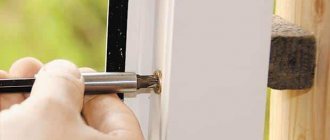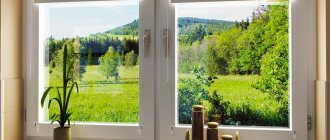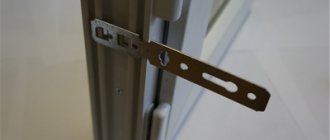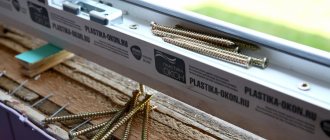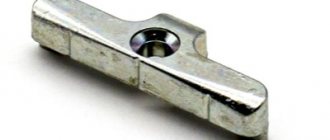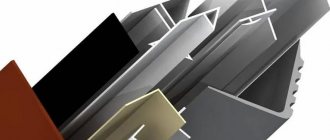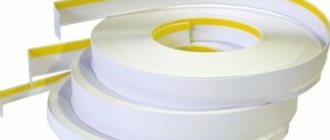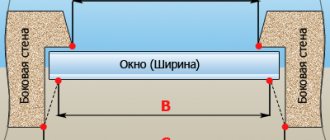Hello readers! I haven't written on the blog for a long time. The season for installing and adjusting windows before winter has begun. Everyone wants to stay warm.
So, many clients are interested in how we attach plastic windows. I’ll say right away that there is no single fastening.
It all depends on where the window is installed. Therefore we can use anchors or plates. In general, I got tired of answering the same questions and I decided to put them in one article, a link to which they will give to all their new clients.
I hope you find this information useful too. Read, get acquainted.
How to fix plastic windows. Types of fasteners
1. Anchor or frame dowel. It comes with a diameter of 8 mm, but practice shows that the optimal diameter of the frame dowel is 10 mm. In my opinion, the most reliable and convenient fastening for windows.
Available in different lengths: 72 mm, 92 mm, 112 mm, 132 mm, 152 mm, 182 mm, 202 mm. Used as follows:
A hole is drilled in the window frame using a metal drill with a diameter of 10 mm. Then, using a hammer drill, a hole is drilled in the concrete, right through the frame.
Next, the frame dowel is inserted and driven into the concrete until it rests against the frame. Then the screw is tightened. There is an opinion that the dowel should be recessed inside the profile.
I consider this optional. Therefore, as for the dowel head, there is even a special decorative plug. And the fastening strength in both cases is almost the same.
2. Anchor plate. For each type of window profile, especially popular ones, a certain type of anchor plate is produced. But since, according to the technology, the plates need to be screwed to the window frame, you can use any window plates (only for the sake of economy, of course).
By the way, regarding screwing the plates into the frame. There are so-called crab plates. That is, they cut or snap into the profile.
So, if there is a quarter in the opening, many installers do not screw such plates. The window will not fall out, and this is the most important thing. After all, a quarter holds the window.
It must be said that there are cases (nowadays less often) when window installers, grossly violating installation technology, do not use fasteners at all. Simply fix the window with wedges and fill it with polyurethane foam.
I hope such cases will pass you by.
3. Wood screws. Used for attaching windows to wood. The cheapest fasteners, and this is probably the only plus.
4. Screw for concrete. I think it is only used in Europe. I went to the professional store “Fixtures” in St. Petersburg, where you can buy a lot of things, and talked with the sellers. They don't have these screws.
Sealing
The sequence of sealing the gap from the outside and inside:
- PSUL;
- polyurethane foam;
- vapor barrier film.
PSUL tape is glued along the outside of the plastic window between the profile and the quarter or along the edge of the end and the window opening. Carefully pry and wrap 2 cm of protective film on the adhesive side. Insert and secure the tape to one of the bottom corners of the window. Lay the strip around the perimeter and, gradually removing the film, press the PSUL to the window. Then remove the protective film so that the strip begins to expand. The PSUL is attached from the bottom at the end.
Attach a vapor-permeable film to the inside of the window along the edge, removing the protection from the adhesive side only partially.
Fill the gap with mounting foam from bottom to top. Fill gradually 20–30 cm at a time and then take a break until the foam gains volume. Filled gaps are sealed with vapor-permeable film.
How to attach plastic windows to brick?
Brick is a good material for building buildings.
But attaching plastic windows to brick is sometimes problematic. What exactly is the difficulty? If you use a frame dowel, then it is better to drill holes in the frame for this dowel not in advance, but in place.
This is necessary in order to get the anchor directly into the middle of the brick, and not into the mortar between the bricks. Of course, no one does this (by the way, neither do I). After all, this is a waste of time.
It is advisable to choose a frame dowel of the longest possible length (minimum penetration into the brick is 6 - 10 cm). If the brick is hollow, then use the 202nd anchor.
You can use anchor plates in brick if you are sure that the brick is not hollow. But even solid brick can be of poor quality. And it will be very difficult for a non-professional to attach the plate into it.
Exterior finishing
After installing a plastic window on anchor plates, it is necessary to design the outer slope. In this case, both decorative and practical purposes are pursued, because uncovered foam tends to gradually deteriorate when exposed to weathering. The simplest option is to use plaster or starting putty for this. When applying the solution, it is important to ensure complete coverage of the installation joints. As for the interior decoration of the slope, it is usually carried out at the same time as the general renovation of the premises.
Plastering window slopes
How to attach plastic windows to wood?
The ideal option for fastening windows for wood is anchor plates.
And no one can convince me of this. Frame houses or timber, plates only. From my bitter experience, I’ll tell you how I fastened windows with screws to the top of the frame in a house made of timber. And there was a casing, and a gap of about 4 cm. A year later, the timber began to shrink, and these screws, together with the timber, went straight into the double-glazed windows.
As a result, several double-glazed windows were replaced under warranty. Got the money. After this incident, if I use screws, then only in exceptional cases, and only in the side parts of the window frame.
By the way, even when building frame houses, professionals do not recommend using hardened screws. Wood is a living material and when moved, screws break, and a nail, for example, bends. The same principle applies to the anchor plate.
Anchor plates for wooden houses are good for the following reasons:
- Quick installation;
- Compensates for thermal expansion;
- They do not affect window structures during shrinkage.
Expert advice: what aspects of installing plastic windows should be taken into account
Specialists who specialize in installing plastic windows in wooden houses advise, when installing them yourself, to take into account several main aspects that may affect the quality of their service.
- Functional features of the casing structure for window openings:
- withstands shrinkage loads;
- does not allow logs to move;
- strengthens the walls in the area of gaps for plastic windows.
In no case should this installation element be ignored; in its absence, deformation of window openings in wooden houses is inevitable.
- Sufficient amount of construction foam.
This substance must fill all the cracks, gaps and voids to ensure a tight fit of the window structure to the wood beam. - Competent and correct installation of the window sill:
- voids should not be allowed to form under the window sill, since the appearance of cracks and gaps leads to drafts;
- The proportional width of this window element must be calculated (large window - wide window sill, small window - narrow window sill).
- The configuration of the window model - the simpler its design, the easier it is to perform installation work.
- Preliminary work, which may include dismantling old windows.
- Age characteristics of the wood structure itself (the younger the house, the more likely it is to deform during shrinkage).
If the above aspects are not taken into account during the installation process, then the design of plastic windows in wooden houses will often have to be changed due to deformation of the walls and window openings.
How to fix plastic windows in concrete?
If you mean good quality concrete, from which, for example, lintels are made over window openings, then drilling such concrete with a diameter of 10 mm under a frame dowel is a bit difficult, but it is possible.
In this case, it is better to use anchor plates. But it is more efficient to attach panel and block houses to a frame dowel. It's more reliable and faster.
At the beginning of the article, I said that the choice of fasteners for windows also depends on the type of structure. So I want to talk about this type of glazing of loggias and balconies.
Typically, the window fastener hits the very edge of the top concrete slab or the edge of the brick bottom and side walls. Therefore, attaching loggias to the edge of the wall using a frame dowel can be quite dangerous.
Anchor plates are a great way out of the situation.
And finally, I would like to say about the big advantage of anchors, which is at the same time a disadvantage for anchor plates.
When the window frame is attached to anchors, at the time of drilling you level only one vertical plane. And you adjust the second vertical plane after inserting the anchor.
When fastening with anchor plates, you will have to set two vertical planes at once and only after that make holes with a hammer drill. This requires certain skill and skill.
Source: lankins.ru/montazhnikam/chem-krepit-plastikovye-okna.html
Tools and materials
Since we're talking about bolts, let's remember everything that might be needed.
Completed window installation
To carry out the work you will need the following tools:
- Hammer
- Screwdriver
- Jigsaw (if not, a hacksaw will do)
- Hexagons
- Plates
- The above bolts
- Construction foam
- Construction pistol
- Sealant
- Marker
- Pencil
- Meter
- Square
Installation of plastic windows on an anchor
Everything related to the installation of plastic windows on anchors can be boiled down to the following: the anchor fastening system implies a through hole in the window frame, which undoubtedly violates its integrity, resulting in depressurization of the profile chambers.
In addition, the anchor is driven into a brick or concrete wall, and, as already mentioned, passes through the profile of your plastic window, coming into contact with the reinforcement of the profile system inside.
The result of such interaction can be icing and freezing of the double-glazed window, and as a result - its fogging, in addition, there is a possibility of flowering of the slopes. The second concern when installing PVC plastic windows on anchors is the possibility of stretching the window profile structure if it is not installed carefully.
After the installation is completed, returning the frame to its normal position will be quite problematic.
In addition to these disadvantages, it is important to highlight, perhaps, the main advantage of anchor installation - high reliability of fastening and quick readiness of the window for use, this is especially convenient when installing balcony blocks.
Dismantling
Since the technology for installing plastic windows requires a free opening, the first thing we do is get rid of the old window. Why do we first remove all the removable sashes, and take out the glass from the blind ones. Now you need to remove the frame. This is where you have to work hard, especially when it comes to old windows. Because, although the doors themselves have long since dried out and acquired, to put it mildly, a not entirely presentable appearance, the frame, as a rule (and oddly enough), was made of excellent wood, which even after many years is too tough for even the sharpest saw . Therefore, for dismantling it is best to use a grinder, and put a metal circle on it
We make deep cuts in the frame in several places and on all sides, after which we carefully remove it piece by piece with some available tool (say, a crowbar). Then we get rid of the old window sill in the same way.
We clean up after ourselves, clearing the opening of all kinds of debris (of which there will be so much) and dust.
Installing a plastic window using a plate
Now let's move on to the issue of installing plastic windows using plates. The main advantage of this method is that the installation process is reduced to a minimum, that is, there is no need to dismantle the double-glazed window before installation.
In addition, here you no longer need to make holes in your window with a through anchor, and accordingly there is no need to violate the integrity of the chambers of the profile system, and this, in turn, will prevent your double-glazed windows from freezing in the Russian winter.
With this installation method, the likelihood of stretching the plastic window frame is minimized, which is also very important. When using this installation method, many do not like the fact that the fastening plates stick out along the entire perimeter of the window, but with proper finishing of the slopes, this drawback can be successfully hidden.
It would seem that the disadvantages are not visible, the advantages are obvious, then a natural desire arises to fix the entire window frame on plates. However, not all so simple.
If your window has openable sashes, then when they are constantly opened and closed, shock loads will occur on the frame of the plastic window, so fastening with anchors is much more reliable. Installation of windows exclusively on plates is allowed when installing only a fixed window.
That is why combined fastening is increasingly used: the upper part of the frame is secured with plates, and the lower part is fixed with anchors.
This method provides more precise adjustment of the window with anchors and makes it possible to align the window horizontally and vertically as smoothly as possible, as well as reduce the share of disadvantages that come with installing plastic windows only on anchors!
Source: evrookna-pskov.ru/poleznaya-informatsiya/sposoby-krepezha-okon.html
What it is?
You can purchase the necessary fastening only if you have a good understanding of what an anchor plate is. This is a flat metal piece with several holes for fixing. As a rule, it is made of steel that has undergone a galvanizing process, which protects the material from corrosion and other external influences.
The use of anchor plates provides a number of advantages.
- Allows the use of fasteners in high humidity.
- The plate can be easily disguised using decorative elements, a window sill or a slope, and it will not be noticeable.
- There is no need to drill through the frame profile, as is the case with self-tapping screws.
- Metal parts reliably protect windows from strong winds and deformation caused by temperature changes. This type of connection is the most durable and remains elastic.
- Windows are easy to level or slope.
- Hassle-free removal of the fasteners if necessary - they can be easily unscrewed. Possibility to choose fixation points as desired.
- You can always reinstall the window covering.
- Installation using plates is more economical in time and costs - hardware has an affordable price.
Such fastening is considered ideal when the window profile is mounted into a wall made of adobe, hollow brick, or timber, that is, it has a loose base. However, it should be remembered that it is better to fix large window structures with special dowels through the frame profile, since the plates are not able to support their weight. Therefore, use is only appropriate for medium-sized windows.
Perhaps this is a certain drawback of the popular lock, as well as the fact that it is better to use it in case of infrequent opening of the sashes or for a blind window. But if you need to install a product of a non-standard shape, a polygonal, trapezoidal or arched model, it is always better to use rotary hardware instead of the usual anchor.
How to choose fasteners for a plastic window - advice from a builder
Replacing outdated wooden window frames in residential buildings in Klin, Solnechnogorsk, Zelenograd with new designs of translucent blocks has become so popular that many home craftsmen began to do this work themselves.
After all, you can watch the actions of a trained master builder when installing a plastic window.
However, good practical skills in performing plumbing and construction work and the availability of the necessary tools are not always sufficient to perform such operations.
You also need knowledge of the specific features of the technology for installing structures, the rules of installation on various walls, and the use of fasteners.
Modern trade provides a large assortment of bolts, screws, plates and other fasteners that are designed for installing plastic windows.
Such a variety of parts, combined with advertising, can complicate the choice for an inexperienced buyer because each specific model is designed for specific operating conditions. They must be taken into account.
Before starting work on installing a plastic translucent block, you should take into account the material and condition of the walls of the window opening on which installation will be carried out in order to correctly select fasteners that will reliably fix the entire structure.
To install plastic windows, the following are most often used:
- anchor bolts;
- special screws for fastening in concrete;
- anchor plates.
Filling cracks with foam
Diagram of a gun for polyurethane foam.
After you have installed all the plates and checked the positions of the frame one last time, the gaps between the window and the slopes must be filled with foam. Make sure that the gap is completely filled with foam. If the gap is large, then work in 2 stages. First put 1 layer, wait about 1.5-2 hours and blow another 1 layer.
Pay attention to the foam characteristics. Because it expands differently at different temperatures. Therefore, select the material taking into account the season. Usually the manufacturer puts a “winter” marking on the cylinder. Read the instructions on the label carefully. The temperatures that are optimal for working with foam are indicated there.
Treat the gaps carefully and carefully. Remember that too thin a layer can lead to drafts in the room. And excess foam will deform and bend the aluminum frame profile. Then the entire window structure will warp. Make sure that splashes do not get on the plastic of the window, as it will be difficult to clean them off. Excess foam can be immediately cut off with a stationery knife. When finishing the window opening, the foam will need to be protected from exposure to sunlight, and this must also be taken into account during installation.
anchor bolt
Builders call it an anchor dowel or an anchor and recognize it as the most reliable element for fastening window blocks. Its kit includes:
- threaded bolt at the end;
- plastic sleeve;
- construction sleeve.
Principle of operation
To fasten the structural element, a hole is drilled in the wall, into which the sleeve and bushing are inserted sequentially.
The anchor bolt is screwed into the sleeve through the hole of the fastened part, wedging it so that an expanding effect is created on the sleeve, which expands and holds all the elements.
Advantages
The reliability of fixing the PVC window structure, combined with a convenient installation process, is considered the main advantage of fastening with an anchor bolt. Therefore, it is used to connect building parts to any solid foundations.
But this work is difficult to redo; it must be done immediately with high quality. Dismantling the anchor connection to adjust the position of the window horizontally or vertically is very problematic.
An anchor that is rigidly fixed in the wall requires a lot of effort and time to remove. Therefore, such reliability of fastening under certain circumstances negatively affects the use of anchor bolts.
Flaw
Multilayer walls with voids filled with insulation are considered to be a problem area for using anchors. The absence of a homogeneous dense medium prevents reliable fixation of the sleeve in the prepared hole when screwing in the bolt. The spacer created by the anchor in the hollow medium has nothing to hold on to.
Sizing Guidelines
The depth of the hole in the wall corresponds to the sleeve inserted into it, and the bolt secures the frame to the opening. But the gap between the wall and the PVC window frame can be arbitrary from 2 to 7 cm. It determines the length of the dowel.
For a distance of up to 3 cm, choose an anchor bolt with a length of 110 mm, and for a distance of 7 cm - 160 mm.
Sealing tapes
To ensure that the plastic window does not lose its protective functions after installation, it is necessary to use sealing tapes: vapor-permeable, vapor-tight, or self-expanding.
Vapor-permeable sealing tape is intended to seal the junction of the window frame and the wall on the outside of the building and to protect the insulating layer from water that can enter from the outside. Vapor-tight is intended to seal the same joints, but from the inside of the room.
Self-expanding tape as a sealant is mounted between the window and the wall on the outside of the house and often acts as an addition to the mounting foam, protecting it from destruction under the influence of ultraviolet rays. Self-expanding sealing tape tends to fill all the empty space between the frame and the window opening, increasing in volume.
Screws for fastening in concrete
In everyday life they are called turboprops, dowels or even self-tapping screws for concrete. They have sufficient holding forces that allow them to be successfully used when fixing PVC windows to the wall.
Advantages
- reliable fastening in durable materials;
- accessibility of dismantling to make adjustments or replace parts.
Flaw
It cannot be used with a non-uniform structure of multi-layer walls due to the presence of voids with heat-insulating inserts in them.
Size selection
The length of the dowel, as well as the anchor bolt, is influenced by the size of the gap between the window frame and the opening in the wall.
Anchor plates
They are used as the most modern method of fastening translucent devices, developed taking into account the influence of temperature affecting window frames under different weather conditions due to the elasticity of the material. In addition, only they are able to reliably hold a PVC window in a multi-layer wall.
Fastening principle
On one side, the plate is fixed to the end part of the window frame, and on the other, it is fixed in the wall with an ordinary dowel 5–8 cm long.
Types of structures
Manufacturers produce anchor plates:
- rotary;
- non-rotating.
The rotating model is convenient to reorient on the frame without drilling holes if unexpected obstacles arise while drilling a concrete wall, for example, reinforcement hitting a rod. Simply moving the plate in a new direction maintains the integrity of the window frame.
Technical parameters of self-tapping screws: how do hardware differ?
If we turn to the international classification of self-tapping screws, their parameters determine the number of turns per inch, length in inches, diameter.
The diameter is determined by a one- or two-digit number. The higher its value, the larger the size of the screw. For example, screw #6 is larger than screw #4. Self-tapping screws for wood and metal sheets are also indicated with a single or double digit number. Sometimes the marking is presented in the form of a fraction.
Threads per inch are sometimes confused with thread pitch. To understand, the pitch is the distance from one thread to the next. In the inch series, this is the number of complete threads per inch. There are self-tapping screws with coarse and fine threads. Their features:
- less risk of breakage when cutting large threads;
- Rough thread is not easy to damage during transportation;
- there is a list of materials that are best used with large threads;
- fine threads are better suited for cutting thin and hard materials;
- thin threads are better for adjustments;
- Self-tapping screws with fine threads are more durable when stretched.
The length is measured from under the head of button, tongue and groove, flange, hex, flat, round, end, and anchor hardware. The length value includes the height of the head in such types of fasteners as flat and oval.
Features of installation of plastic windows
- There is an opinion among builders that anchor plates are not reliable enough. But manufacturers prescribe such fastening with the obligatory use of polyurethane foam, which, when hardened, creates a reliable fixation of the window in itself. But the use of mineral wool or any other sealants is unacceptable.
- Anchor plates are produced for a specific plastic window design by each manufacturer according to their own standards. This must be taken into account when purchasing fasteners. Using plates, for example, from Rehau, to fasten windows of a different design can create a problematic situation.
When choosing fastening elements, take into account the design features of windows and walls. This will help you make the right choice for installing a specific model.
If necessary, you can consult with specialists at a window company, who with their advice will make it easier for you to install PVC windows yourself.
Source: okna-systems.pro/articles/poleznoe/kak-vybrat-krepezh-dlya-plastikovogo-okna-sovety-stroitelya
Average prices in the Russian Federation
When ordering installation of a window structure from one company, anchor plates are usually supplied as a set and are already included in the total cost. If it is necessary to purchase these elements separately, manufacturers offer approximately the same prices:
- Fixed plate 150x25x1.2 - average price 25-30 rubles. for 1 piece
- Extended fixed plate 190x25x1.2 - average price 35-40 rubles. for 1 piece
- Rotating plate 150x25x1.2 with a crimp joint, average price 50-60 rubles. for 1 piece
- Set of fixed plates 150x25x1.2 of 10 pcs. offered by suppliers at a price of 190-210 rubles.
On a note. Depending on the number of items in one order, the price may vary. When purchasing 1000 or more plates with identical characteristics, wholesale prices apply, which may differ 2-3 times from retail prices.
